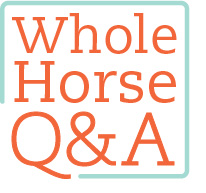
Q My barn has box stalls and large, shady paddocks. My two geldings usually eliminate outside, but my 5-year-old mare stays in her stall 24/7 in all weather. She eliminates there, then walks through it, creating a mess that requires frequent cleanings. When I work her in a nearby pen, she doesn’t seem to mind being outside. Would feeding her in her paddock, instead of her stall, encourage her to go out more?
STACY HAWES, Ohio
A It sounds as if you’ve provided a great environment for your horses, with options of being inside or heading outside for visual stimulation and exposure to the elements if they choose. Two of your horses take advantage of this and eliminate in that location, as well. That’s a boon to the cleaning process—plus saves on shavings.
Your young mare, however, seems to feel safer or at least more comfortable in her stall. She therefore also eliminates there, which is normal under the circumstances (see box).
To get your mare using her outdoor space more, make that area more inviting for her. Putting food and water outside is a good method if she’s willing to go outside to eat and drink. If she does, she’ll start associating this area with good things, plus become more likely to start eliminating there, saving you work and bedding.
If she’s too fearful to go outside, however, then it would be dangerous to place her food and water there, as she might wind up not eating or drinking for a few days, which can lead to problems like dehydration or even colic. If this is the case, you need to scrutinize the paddock area and beyond “through your mare’s eyes” and become a bit of a behaviorist yourself.
Where Do They ‘Go’? Most horses don’t like to eliminate on hard surfaces and will instead choose a softer, more absorbent area to do their business. They also tend to eliminate in the areas where they most often walk and eat. Only stallions commonly interrupt what they’re doing to eliminate in a specific area; these are known as “stud piles.
Look for anything that might seem frightening to her. Maybe the other horses are too close to her, and there’s social conflict. In that case, changing her to a different stall could help. Maybe you have predators in the area. If so, ask her to go outside only during the day when she feels safe, and you might even close the stall door at night. Maybe there are nearby sounds that are frightening her, and you could simply leave some music playing to help distract her.
Start routinely haltering her and leading her outside to the paddock. As you do, observe her body language. Is she relaxed and calm, or alert? Does she follow her regular cues, or does she refuse to do so or seem distracted? If she’s alert and refuses to comply with cues, then she’s likely frightened. If she’s calm, begin grooming her in the paddock, especially if she enjoys being groomed. You can also do some clicker and target training in her paddock. (Review “Click to Motivate Your Horse” at HorseandRider.com.)
Once she’s comfortable in the paddock, start providing fewer or no shavings in the stall, instead creating an inviting area in the paddock with shavings and/or sand to encourage her to eliminate outside.
JEANNINE BERGER, DVM, DACVB
Director of Behavior Resources
San Francisco SPCA






